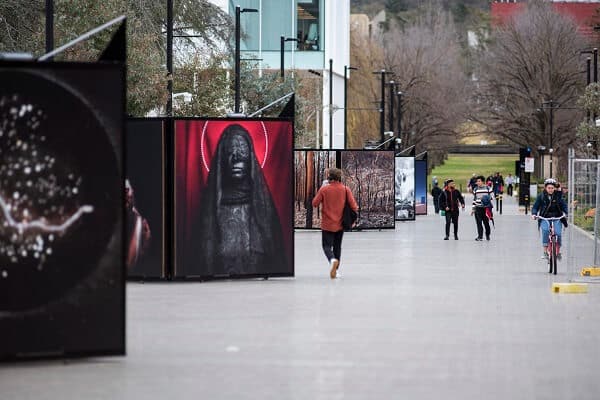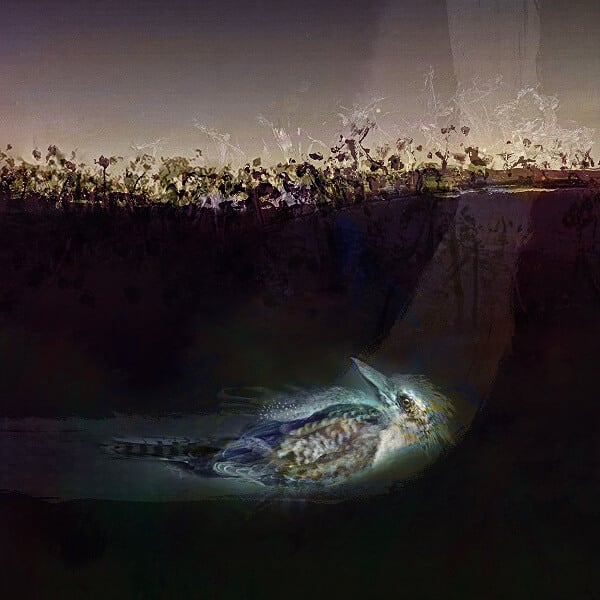A new public art space has dropped on the Kambri precinct hub at ANU in Canberra. The outdoor corridor along University Avenue has been transformed into a 24/7 exhibition space hosting a free program of multidisciplinary exhibitions and art activations by both emerging and established artists all year round. This initiative is curated and produced by aMBUSH Gallery, the multi-award-winning gallery and social enterprise who are integral in the development of arts and public space projects across metropolitan and regional Australia.
Until 31 October the inaugural exhibition ‘Where I Stand’ featuring 24 striking large-scale photographic works by six talented Australian artists will be accessible to audiences around the clock on Exhibition Avenue. Curated by aMBUSH Gallery, in partnership with Head On Photo Festival.

The captivating series of single frame shots by artists Michael Cook, Dr. Judith Crispin, Sarah Ducker, Murray Fredericks, Barbara McGrady and Michael Jalaru Torres, pose powerful visual expressions of deeply personal understandings and experiences of transformation, rebirth, identity, history, nature, connection and the Dreamtime.
Michael Cook’s work explores issues of identity. His evocative photographic re-creations escort wrongful doings from Australia’s colonial past to the present, and brings together the historical with the imaginary, the political with the personal. He says, “‘Mother’ is my most intensely personal work to date. While these images speak directly and poetically to Australia’s Stolen Generation, they speak also to a universal experience of disconnection between mother and child. In their power they evoke the essential nature of the relationship between mother and child that is at the heart of human experience.”
Dr. Judith Crispin is a Canberra-based poet, visual artist, creative director for cultural heritage projects, academic, photographer and writer with a background in music. Crispin is concerned with stories of displacement and identity loss, the concept of connection with Country, and her personal experience of loss of Aboriginal ancestry. Crispin exhibits a series of animal portraits depicting kangaroo, snake, kookaburra and parrot in visualisations of transient time, their spirit leaving the physical world and rising up to the sky.

Sarah Ducker’s photographic representations treasure the ephemeral beauty of the natural world. In this series Ducker captures the miraculous resilience and majesty of the Australian bush where burnt trees stand tall and defiant after the ravage of recent bushfires. She says, “As I walked across the earth still pungent with the firestorm, surprisingly, I was uplifted by the transcendent glory of the naked trees. In the midst of this apocalypse emerges not just the possibility of transformation, but the insistence of it.”
Murray Fredericks series of four images are drawn from his Salt Project (2003–2019) produced at Kati Thanda (Lake Eyre), South Australia. Fredericks exquisite visions dwell on the notion of becoming absorbed mind, body and spirit in the infinite nature of the landscape. “Stay there long enough, and the landscape forces you to a place beyond the rational mind, beyond your sense of self. It’s a part of the human condition we experience when confronted by concepts of infinity, absorbed in meditation, or when confronted by our own mortality. The contours of the landscape dissolve into a limitless optical deception,” says the artist.
Michael Jalaru Torres is a self-taught Indigenous fine art photographer and media professional whose creative output is inspired by the unique landscapes and people of the Kimberley region of Western Australia, his own history and experiences, and the social and political issues facing Indigenous people today. “I capture my culture from my perspective using the tools of the camera and pen. My photography strips away the noise and focuses on the subject to create minimalist art of light and shadow over skin and landscape, illuminating the dark history of Australia with modern day themes that shape our communities both remote and urban,” Torres shares.

Aunty Barbara McGrady is a Gamilaroi/Gomeroi Murri Yinah (Woman) passionate about telling the true stories of contemporary Aboriginal life, and documenting her mob’s achievements across a diverse range of experiences including politics, sport, dance, song, community, and family. McGrady’s imagery draws focus to the ongoing conflict between Aboriginal culture, spiritual connection to country, and Australian colonial sensibilities. A series of four captivating shots depict Aboriginal dancers and smoking ceremonies taking place across various community events.
Bill Dimas, co-director of aMBUSH Gallery says “We’ve worked together with the artists to bring a carefully selected body of artwork, rich in storytelling and meaning at this critical time where our world is overwhelmed by a negative news cycle. Where I Stand transports you into a beautiful world of ancient wisdom, cultural renaissance and human connection.”
To stay up to date with upcoming exhibitions and events visit Kambri at ANU here or follow on Facebook and Instagram. Visit aMBUSH here. Kambri is located in the grounds of The Australian National University, Canberra.